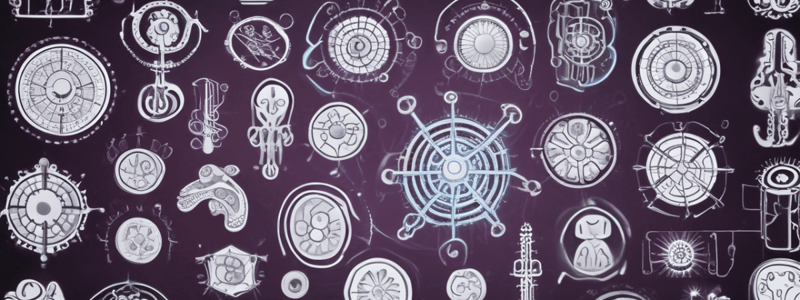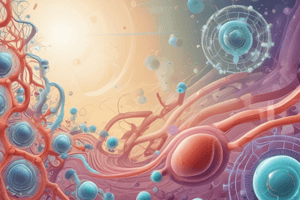Podcast
Questions and Answers
What is the primary focus of biochemistry as a field of study?
What is the primary focus of biochemistry as a field of study?
- The structure and function of organelles
- The breakdown of lipids, carbohydrates, and proteins
- The classification of elements in the periodic table
- The study of the structure, composition, and chemical reactions of substances in living organisms (correct)
What is the charge of a proton?
What is the charge of a proton?
- (+) (correct)
- Variable
- 0
- (-)
What is the location of electrons in an atom?
What is the location of electrons in an atom?
- Organelle
- Molecule
- Orbital/Shell (correct)
- Nucleus
What is the main purpose of the periodic table?
What is the main purpose of the periodic table?
What is the smallest unit of a substance that can exist by itself or be combined with other atoms to form a molecule?
What is the smallest unit of a substance that can exist by itself or be combined with other atoms to form a molecule?
What is the primary function of peroxisomes in a cell?
What is the primary function of peroxisomes in a cell?
Which of the following organelles is involved in DNA replication and forms cilia and sperm tails?
Which of the following organelles is involved in DNA replication and forms cilia and sperm tails?
What is the function of microvilli in a cell?
What is the function of microvilli in a cell?
What is the primary function of the nuclear envelope?
What is the primary function of the nuclear envelope?
Which of the following cells does not have a nucleus?
Which of the following cells does not have a nucleus?
What is the function of flagella in a cell?
What is the function of flagella in a cell?
What is the primary function of the centromere?
What is the primary function of the centromere?
What is the term for chromosomes of the same size and centromere location?
What is the term for chromosomes of the same size and centromere location?
What is the term for the condensed form of a DNA strand?
What is the term for the condensed form of a DNA strand?
What is one of the structural features of the cell?
What is one of the structural features of the cell?
What is the primary function of the mitochondria in a cell?
What is the primary function of the mitochondria in a cell?
What is the main difference between rough ER and smooth ER?
What is the main difference between rough ER and smooth ER?
What is the purpose of the Golgi Complex in a cell?
What is the purpose of the Golgi Complex in a cell?
What is the name of the structure that seals between adjacent cells?
What is the name of the structure that seals between adjacent cells?
What is the name of the fluid inside a cell, excluding the nucleus and mitochondria?
What is the name of the fluid inside a cell, excluding the nucleus and mitochondria?
What is the primary component of the plasma membrane?
What is the primary component of the plasma membrane?
What is the site of pyruvate oxidation in a cell?
What is the site of pyruvate oxidation in a cell?
What is inherited from one's mother in a cell?
What is inherited from one's mother in a cell?
Flashcards are hidden until you start studying
Study Notes
Course Introduction
- Course code: NURS 1110
- Credits: 3
- Course delivery: Lectures with in-class demonstrations
- Course assessment: In-course exams, group project, and multiple sclerosis
- Textbook: Handbook of Applied Biochemistry, Nutrition and Dietetics for Nursing and Allied Health Students
Unit 1 - Molecules and Chemical Reactions
- Week 1-3: Introduction to biochemistry, molecules, and chemical reactions
- Definition of biochemistry: Study of the structure, composition, and chemical reactions of substances in living organisms
- Definition of an atom: Smallest particle of a substance that can exist by itself or be combined with other atoms to form a molecule
Atomic Structure
- Components of an atom: Proton, electron, and neutron
- Proton: Positive charge, mass 1, located in the nucleus
- Electron: Negative charge, mass 1/1840, located in the orbital/shell
- Neutron: No charge, mass 1, located in the nucleus
Cell Structure and Function
- Cell components: Plasma membrane, cytosol, cytoplasm, mitochondria, endoplasmic reticulum, Golgi complex, lysosomes, peroxisomes, centrioles, and nucleus
- Plasma membrane: Separates the cell from the external environment, selectively permeable, and has special surface structures for attachment and communication
- Cytosol: Intracellular fluid inside a cell, separate from the nucleus and mitochondria
- Cytoplasm: Content within a cell membrane, excluding the nucleus
- Mitochondria: Sites of cellular respiration, responsible for ATP production from food molecules
- Endoplasmic reticulum (ER): Membrane-bound channels, provides skeletal support to the cell, and has two types: rough ER (protein synthesis) and smooth ER (lipid synthesis)
- Golgi complex: Membrane-bound structure, responsible for protein reception, finishing, packaging, and transportation
- Peroxisomes: Circular membrane-bound structures, contain enzyme peroxidases, and detoxify by removing harmful metabolites
- Centrioles: Rod-shaped structures, used in DNA replication, and form into cilia and sperm tails
- Nucleus: Spherical structure, stores genetic material, and has a double membrane with nuclear pores
Special Cell Structures
- Microvilli: Microscopic cellular membrane protrusions, increase surface area, and minimize volume increase
- Cilia: Slender tubes that project from the cell body, serve as sensory organelles
- Flagella: Whip-like structures, allow cells to move, and are used for locomotion
Studying That Suits You
Use AI to generate personalized quizzes and flashcards to suit your learning preferences.




